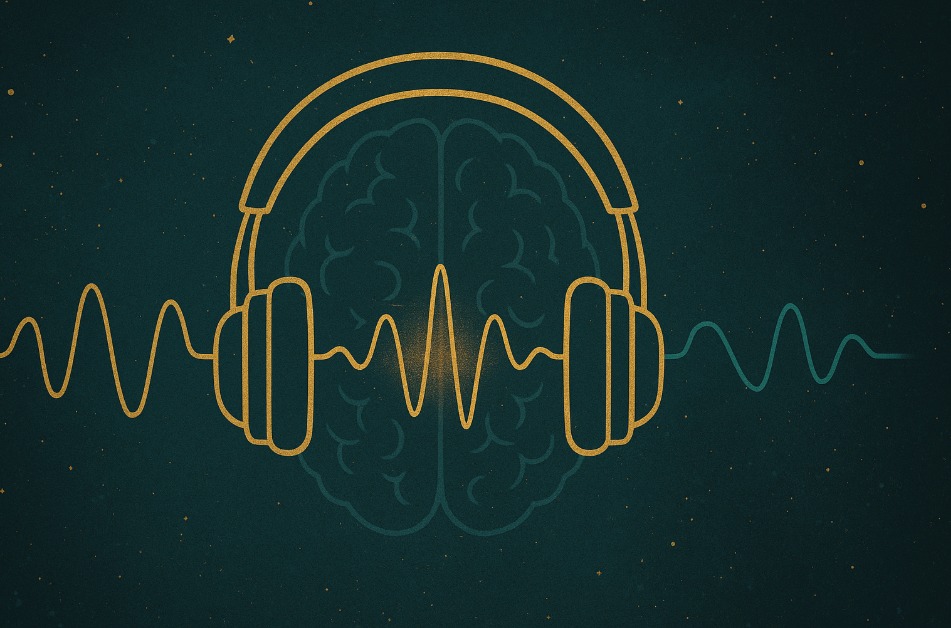
Binaural beats
An effortless audio tool to nudge your brain into calmer, clearer states.
Binaural beats are a listening technique where you wear headphones and play two slightly different tones—one in each ear. Your brain perceives the difference between those tones as a gentle “beat” (for example, 200 Hz left ear and 206 Hz right ear feels like a 6-Hz pulse). Many people use these subtle pulses to relax, focus, or drift into sleep.
Purpose
1. Calm mental overactivity and soften stress.
2. Support focus for study, creative flow, or deep work.
3. Ease the transition into rest or sleep.
4. Offer an effortless option on days when active practices feel heavy.
How It Works
1. Two tones, one beat — The perceived rhythm equals the difference between the tones (the “beat frequency”).
2. Headphones required — Each ear must receive a different tone for your brain to blend them.
3. State targeting — Different beat ranges are associated with common mental states:
➡ Delta (0.5–4 Hz): deep sleep, restoration
➡ Theta (4–8 Hz): relaxation, creative drift
➡ Alpha (8–12 Hz): calm, present focus
➡ Beta (12–20 Hz): alert concentration
(These associations are general, not guarantees.)
4. Gentle entrainment — The steady pulse can encourage your brain to “settle” toward that rhythm, similar to how a metronome steadies a musician.
Benefits (reported by users)
➡ Physical: deeper breathing, lowered muscle tension, easier sleep onset.
➡ Mental: fewer distracting thoughts, smoother focus windows, reduced rumination.
➡ Emotional/Spiritual: a felt pause from noise, easier access to meditation or journaling.
Note: Responses vary—think “supportive nudge,” not a magic switch.
How to Use Binaural Beats
Choose your aim
- Focus/creative work: alpha or low beta (8–15 Hz).
- Relax/meditate: alpha or theta (6–10 Hz).
- Sleep: theta → delta (start around 6–8 Hz, drift lower).
Set the scene
- Stereo headphones, comfortable volume (quieter than music).
- Optional soft drone, nature sound, or pink noise underneath.
Timeframe
- Focus: 20–45 minutes (pair with a timer like Pomodoro).
- Wind-down: 10–20 minutes before bed.
- Meditation: 10–20 minutes with easy nose breathing.
Stack smartly
- Pair with 4/6 breathing for faster down-shift.
- Combine with gentle humming for 2 minutes first, then listen in silence.
- Journal one line after: “What do I feel now? What do I need next?”
Safety & Comfort
➡ Use stereo headphones; keep volume low.
➡ If you have a history of seizures, significant tinnitus, or dizziness with audio effects, skip binaural beats or consult a clinician.
➡ Stop if you feel uneasy or overstimulated; switch to quiet breathing.
➡ Not a replacement for medical or mental-health care.
Myths vs. What We Know
Myth: “Binaural beats instantly fix anxiety.”
Reality: They can support calm and focus for many people, but effects differ by individual and context.
Myth: “You need specific ‘miracle’ frequencies.”
Reality: Ranges (alpha/theta/delta) matter more than exact numbers; comfort and consistency matter most.
Myth: “Headphones optional.”
Reality: They’re essential; without them, you’ll just hear a blend—no beat.
Simple Starter Routines
15-minute Calm Reset
2 minutes 4/6 breathing
10 minutes theta (6–8 Hz) at low volume
3 minutes quiet sitting
25-minute Deep Work Block
5 minutes planning + 4/6 breathing
20 minutes alpha/low-beta (10–15 Hz) while working
Short break; repeat if helpful
20-minute Sleep Glide
Warm light off, screens away
5 minutes nasal breathing
15 minutes theta → delta track, volume just audible
Final Reflection
Binaural beats are like a soft metronome for your mind—steady, subtle, and easy to use. On days when your head feels crowded or your energy is thin, putting on headphones can offer a simple doorway into clarity, creativity, or rest. Treat them as a companion to your inner practices, not a replacement, and let the rhythm become the bridge from thinking to feeling, from effort to ease. Free Video – Binaural Beats
